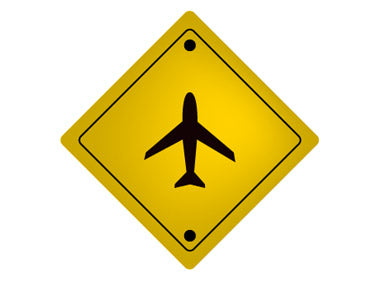In this illustrator tutorial we are going to make a caution street sign using basic shapes. We will use the Mesh tool and some blend modes to give realistic shading and 3D effects.
1 Create a basic shape
Go to File>New and open a new RGB document. Choose the Rounded Rectangle tool from the Rectangle tool list. Click once on the artboard and a dialog that appears, enter 500 pt for the Width and Height, and set the Corner Radius to 20 pt. Click OK. Since this is a typical caution sign, it needs to be yellowish-orange. Open the Swatches panel (Window>Swatches) and choose the preset yellow colour.

2 Copy and paste the shape
Using the Selection tool (V) pick the shape and position the cursor outside one of the corners until it changes to a curved double arrow. Hold down the Shift key and rotate until it snaps into position. Now we have our basic sign shape and
colour. Press Command-C (PC: Ctrl-C) to copy this shape to the clipboard and then choose Edit>Paste in Front to place the object directly in front of the original.

3 Add stroke and lock the selection
Go to the Control panel, set the Fill for the shape to None, Stroke to black, and Stroke Weight to 5 pt. In the Toolbox, double-click on the Scale tool (S) to open the Scale dialog box. In the Uniform section, set the Scale to 90% and click OK. Choose both the objects with the Selection tool and go to Object>Lock>Selection.
4 Add gradient mesh
Go to Edit>Paste in Front. Then open the Swatches panel, and choose a neutral 50% grey. We will use this layer to add shading to the graphic. Move on to the Toolbox, choose the Mesh tool (U), and click inside the shape. Now choose white colour from the Swatches panel. When you apply it the white colour fades out from the anchor point to the base grey colour of the shape.

5 Adding more anchor points
Click in a different area of the shape to add a new anchor point. Now click directly on an existing gridline so that the gridlines share anchor points. Pick a darker grey or black from the Swatches panel to change the colour in that part of the mesh. You can add more points and adjust the shading around those points. You can also change the colour settings of the existing points, if needed.

6 Blend the objects
Open the Transparency panel (Window>Transparency). Choose Select>All, then click on Normal to open the blend mode drop-down menu, and choose Overlay.

7 Adding mounting holes
Remove the selection. In the Control panel set the Fill colour to black. Choose the Ellipse tool (L), hold the Shift key, and drag out a small circle on your sign. Go to Edit>Copy then Edit>Paste. Choose the Selection tool and position the holes on the sign. Open the Align panel (Window>Align), select both circles, and click the Horizontal Align Centre icon. Now add some text or graphics to the sign. Make sure the Fill colour is black and position them in the frame.


8 Making the sign post
Start with the Rectangle tool. Draw a tall, narrow rectangle. Fill this shape with a green colour. Open the Colour panel (Window>Colour) and enter the values manually.

9 Apply the mesh
Select the objects and go to Object>Create Gradient Mesh. In the dialog box, set the number of Rows to 1 and Columns to 3. Leave the appearance to Flat and click OK.

10 Shading
Using the Direct Selection tool (A), locate the third grid line from the left and click-and-drag around the entire length of the line to select the top and bottom anchor points of the line, as indicated by a solid blue colour. Go to the Colour panel and set these anchor points to R: 146, G: 255, and B: 146. Select the grid line to the immediate left using the Direct Selection tool, and set the colour of these anchor points to a darker green using the Swatches panel. Navigate Object>Arrange>Send to Back and then use the Selection tool to position the post behind the sign.

11 Add background
With the Rectangle tool draw a square shape and fill it with a solid blue colour. Go to Object>Create Gradient Mesh. Set the number of Rows and Columns to 2 each. Set the highlight Appearance setting to Centre and Highlight to 75%. Click OK. Position this background graphic over the sign graphic then navigate to Object>Arrange>Send to Back.

12 Rotate the sign
For add designs to the sign, go to Object>Unlock All. Then Shift-click on the target icons to include all the layers that make up the sign graphic. Now select Object>Group, then go to Effect>3D>Rotate. In the Rotate 3D Rotate Options dialog box, set the Perspective to 75°. You can rotate the object in 3D by clicking on the cube and repositioning it manually, or you can input the settings as shown below. Click OK. This puts the object at a more realistic angle.


Final Image







